The next post in our Bird’s Eye View of Glasgow blog series looks at the passenger railway stations of Glasgow in 1864. (Click on the images to enlarge the detail).
The 1800s was a golden age for railways in the UK. Glasgow, a city with a rapidly increasing population, didn’t hesitate to embrace this novel new mode of transport. Prior to rail, passengers wishing to travel to London from Glasgow had to do so by horse drawn carriage; either the stagecoach, or with the mail on the mail coach. The mail coach had 3 stops and took 42 hours to get from Glasgow to London.
Bridge Street Station 1840 – 1901/5
Just south of the river, west of the Glasgow Bridge at Jamaica Street, the Bridge Street Railway Station can be seen. It was Glasgow’s first passenger railway station, and was opened in 1840.
The two railway companies GP&GR (Glasgow, Paisley and Greenock) and G.P.K. & A. (Glasgow, Paisley, Kilmarnock and Ayr) bought land from the Trades House, an organisation of craft guilds. Twenty-two properties were cleared to make way for the tracks and station, and a route between Glasgow, Paisley and Greenock was realised. This area is still known as Tradeston, dating back from when Trades House owned the land.
With the opening of the Bridge Street Station in 1840 travel by rail to London was now a mere 24 hours, taking the rather indirect route of a 13 hour trip between Ardrossan and Liverpool by steamer. Today rail travel between Glasgow and London is 4 hours and 30 mins.
The Ordnance Survey Town Plan above shows Bridge Street Station’s large booking office and grand entrance with stairs and four columns. The booking office front can just be seen on the bird’s eye view. There was a public house called the Railway Arms Tavern to the left of the entrance.
In spite of the grand booking office, it appears that the station itself suffered from a lack of safe passenger space due to its massive popularity and low fares, as rail competed with passenger transport on the Clyde. As a railway traveller (1852) complained in a letter to the Glasgow Herald; “… the carriages cannot get into the sheds, and ladies are daily forced to alight, in the most inconvenient and indelicate manner, at a considerable distance from the station, on the line of rails where carriages are constantly moving. … The trains leaving Glasgow are also started regularly amid crowds of arriving passengers ; and it is perfectly surprising that no lives have yet been lost. … Even on the platform where the passengers should set down, the danger does not cease. It is a narrow stripe of six or eight feet broad [this can be seen on the Town Plan above], on each side of which is a line of rails sunk several feet. Upon this stripe the luggage vans are emptied ; the passengers are crowded together, often jostled over, personally injured, and frequently robbed.” (Glasgow Herald 3 September 1852, p.5).
Today the booking offices, buildings to the right and the tavern no longer exist, replaced with grass and trees.
Queen Street Station 1842 – current
With travel to the south now catered for, two years later in February 1842 the Edinburgh and Glasgow Railway Station (now Queen Street Station) opened next to George Square. The station provided travel to the north, and linked Glasgow and Edinburgh in only two and half hours.
The bird’s eye extract shows Queen Street station going into a tunnel. The tunnel entrance at Cowlairs/Pinkerston can be seen in the 1865 map extract below. The half mile tunnel was built at an incline, with trains originally being pulled and lowered by cable controlled by an engine at Cowlairs. The tunnel “was the most stupendous work of the kind until then seen in Scotland.” (MacGregor, 1881, p. 432). Unlike Bridge Street Railway Station’s overground route, it was felt that a tunnel would have less impact on the area. It was also much cheaper than buying the land and property above ground, which included the city poorhouse.
Buchanan Street Station 1849-1966
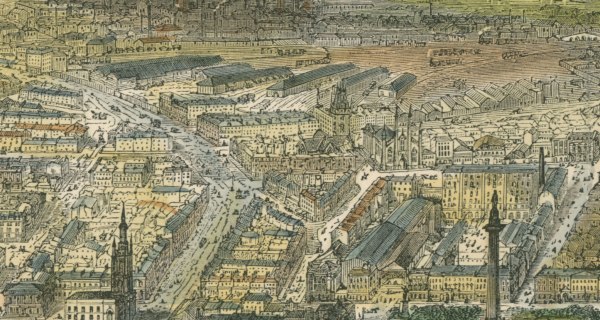
Buchanan Street railway station extract (Sulman, 1864). In the top left corner of the extract the farthest away of the long buildings was the Buchanan Railway Passenger Station. The long buildings in front made up the goods sheds and grain stores of the goods depot. Queen Street Station can be seen at the bottom of the extract.
Buchanan Street Station was opened in 1849 to serve the north and west of Scotland. It was a quieter station, with destinations more for holidaying than business passengers.
The exit from the city boundaries required considerable engineering expertise. While the bird’s eye extract above gives the impression of trains leaving a relatively open area, the 1901 map extract below illustrates an altogether more complicated route.
The hatched lines of the track intersect the Queen Street tunnel running below, leaving only 10 feet between trains. The track then immediately descends into a tunnel that goes below the Monkland Canal.
The journey from the Station platform to the tunnel was less than pleasant, according to journalists reporting on the journey just before the station officially opened;
“To the north-east of the point of divergence from the main line, indeed, a good view of the extensive workhouse of the Barony parish, rapidly rising in form and substance, is to be had; but as you pass onward you are driven into a cloud of thick, heavy smoke, which is continually emerging in volumes from stalks studded closely together as far as the eye can penetrate the general gloom; and, arrived at the celebrated Pinkstone Bog, the olfactory nerves are accosted by the pestilential effluvia of its now dammed up water, together with that of the noxious debris continually issuing from St. Rollox [Chemical] Works” (Glasgow Herald 22 October 1849, p.4).
The industrial chimneys can be seen in the bird’s eye extract. The Bogside can be seen at the top right of the 1901 map extract, next to the tunnel entrance. The St. Rollox Chemical Works (which dumped waste into the bog) lies just to the right of Glebe Street below.
Rail as a form of transport continued to flourish in Glasgow after the bird’s eye view was published in 1864. By the 1880s the city centre of Glasgow had six main passenger railway stations.
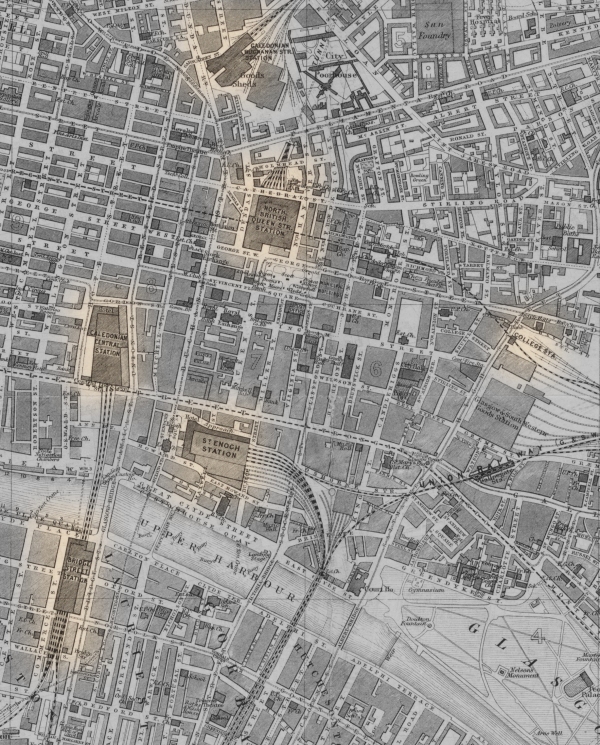
Bartholomew (1901) Post Office Directory extract showing Glasgow’s six railway stations in 1901. Clockwise from top; Buchanan Street Station, Queen Street Station, College Station, St. Enoch Station, Bridge Street Station, and Central Station.
The story of the rise and fall of Glasgow’s many railway stations, and the furious competition of the companies that owned and shared them makes for fascinating reading. For more information see our collection materials and the references below. During the twentieth century the stations slowly closed one by one, with only Central Station and Queen Street Station remaining today.
Other posts in the series can be found here. You are welcome to come up and see the bird’s eye view for yourself, and even order your own copy from the Maps, Official Publications and Statistics Unit on level 7 of the University Library. Just get in touch by email, 0141 330 3176 or pop up to see us Monday to Friday, 9 am to 5 pm.
References
Maps
Bartholomew, J. (1901) New plan of Glasgow with suburbs, from Ordnance and actual surveys, constructed for the Post Office directory, 6 inch, Edinburgh, John Bartholomew & Co.
Ordnance Survey (1859) Glasgow 1st Edition. Town Plan, Sheet 6.10.25, 1:500, Southampton: Ordnance Survey.
Ordnance Survey (1865) County Series Lanarkshire 1st Edition, Sheet 6, 6 inch, Southampton: Ordnance Survey.
Sulman, T. (1864) Bird’s eye view of Glasgow in 1864, Illustrated London News, London.
Monographs
Biddle, G. (1986) Great Railway Stations of Britain: Their Architecture, Growth and Development, David & Charles, London.
The Corporation of the City of Glasgow (1967) Scottish Railway Locomotives : A history of the railways of Scotland and a descriptive guide to Scottish locomotives in the Museum of Transport, Glasgow, The Glasgow Museums and Art Galleries Department, Glasgow
Glasgow Herald (1849) ‘Caledonian Railway – Buchanan Street Terminus (From the Guardian)’, 22 October, Issue 4874, p. 4.
Johnston, C., Hume, J. (1979) Glasgow Stations, David & Charles, London.
Kellett, J. (1969) The Impact of Railways on Victorian Cities, Routledge & Kegan Paul, London.
MacDowall, J. K. (1899, 1970) The People’s History of Glasgow: An encyclopedic record of the city from the prehistoric period to the present day, S. R. Publishers Ltd., Wakefield.
MacGregor, G. (1881) The History of Glasgow: From the earliest period to the present time, Thomas D. Morison, Glasgow.
A Railway Traveller (1852) ‘The Bridge Street Railway Station’, Glasgow Herald, 3 September, Issue 5175, p.5.
Thomas, J. (1971) A Regional history of the railways of Great Britain: Vol VI: Scotland: The Lowlands and the Borders, David & Charles, Newton Abbot.S
Categories: Library, Official Publications
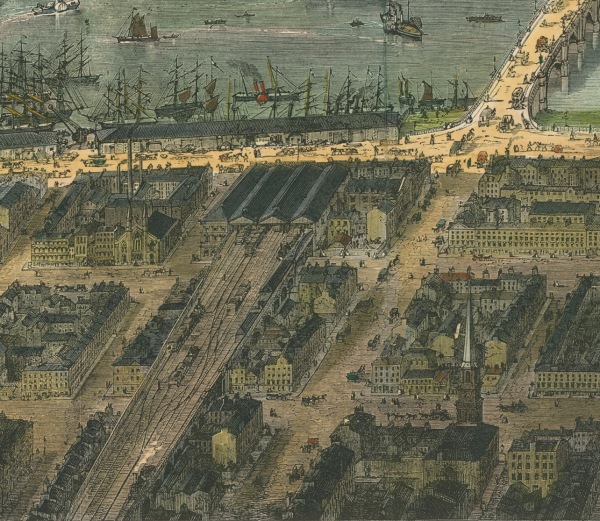
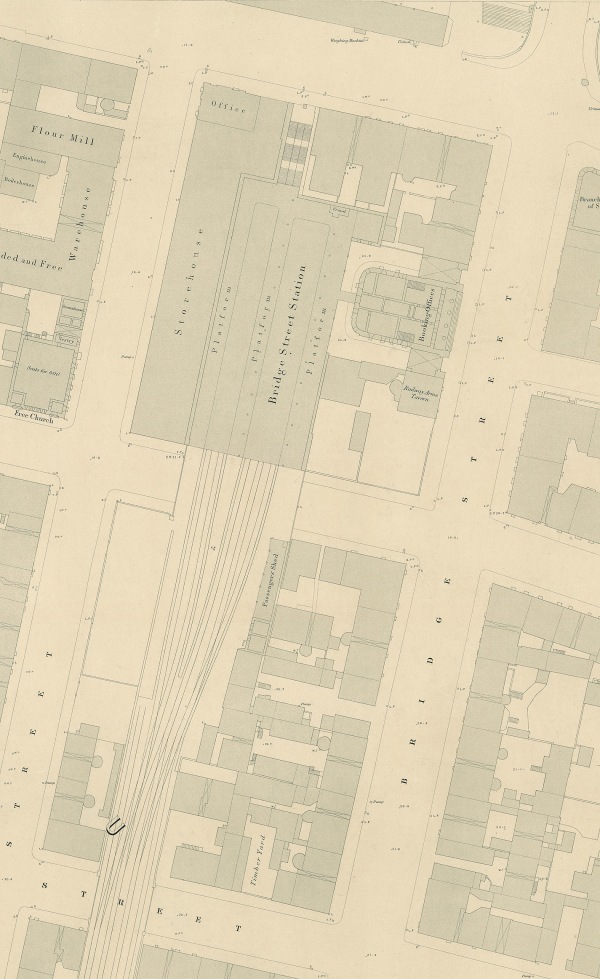
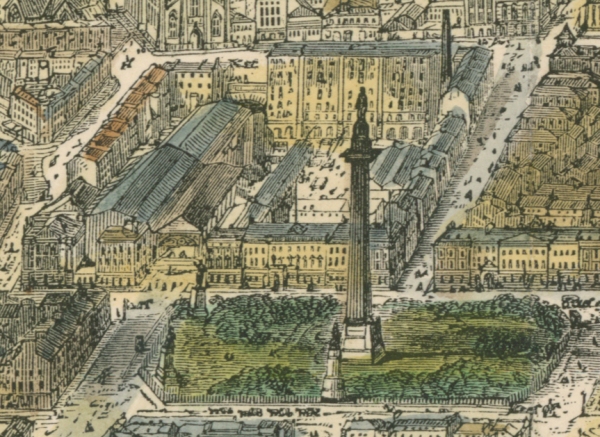
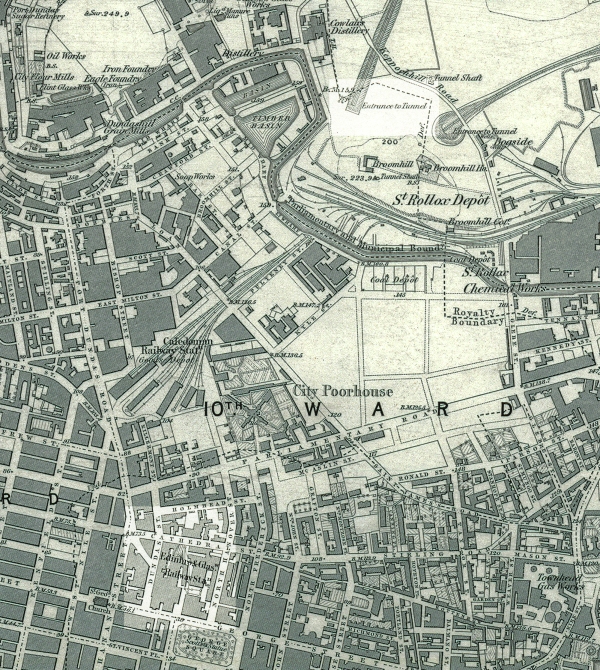
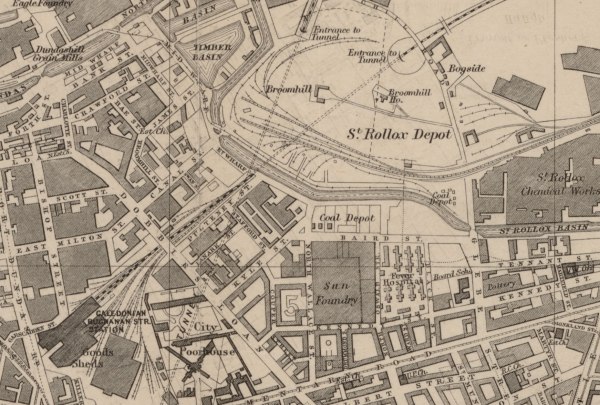
 Miners, AI, and wind turbines : New Official Publications 07.05.24
Miners, AI, and wind turbines : New Official Publications 07.05.24  Fiscal Drag, Vaping, and the United Kingdom – New Official Publications 17.04.24
Fiscal Drag, Vaping, and the United Kingdom – New Official Publications 17.04.24
Was there a child (female) killed by accidentally falling onto the tracks in Glasgow (not sure which station) circa 1840 – 1842? Her surname was Crichton and her parents were Robert Crichton and Janet Frazer of Glasgow.
Hi Susan, Many thanks for your comment. We don’t have the resources to locate this type of information I’m afraid. I think the Glasgow Genealogy Centre may be able to advise, and their contact details are at https://www.glasgow.gov.uk/article/20498/Genealogy-Centre-Enquiry, With best wishes, Elaine
Thanks very much, Elaine. I will try your suggestion. The reason I am looking for this information is because I am related somehow to a William Crichton who was born in Glasgow in 1828 but at about the age of 12 to 14, he ran away on a merchant ship because his younger sister was killed at the train station and he was afraid to go home to tell his mother. They had asked their mother if they could go and watch the trains and she agreed but told them to be careful. His sister was accidentally killed on the track (fell off the platform so the story goes). I checked what year the trains began in Glasgow and your site provided me with the date of 1840 so the date matches his age and time frame.William eventually settled in Samoa and married a Samoan woman and had about ten children. I have had several DNA matches with people who have a fair amount of Samoan ancestry. One woman was born on the island of Savaii in Samoa which was where William lived. All my DNA matches with these people also have Scottish DNA. After some research, I found an older woman had written a book in Samoan about her ancestors and her life. Her son translated it into English and it is online. The Samoan woman’s ancestor was William Crichton. Since I have no Samoan DNA, I must be connected to these matches through this William Crichton. Anyway, it is a fascinating story and I hope to find some evidence of his sister being killed at the train station. Interestingly, your article reveals it was fairly dangerous as the platform was narrow and there were a lot of people pushing their way through. I have found William Crichton’s birth and the names of his parents and siblings so he did exist! His age matches the time frame. I still have no idea how I am related to him though as my Scottish ancestors came mostly from Sutherlandshire and Argyll. Perhaps a branch went to Glasgow for work. It’s a fascinating story.
Thanks again and all the best,
Susan
You’re very welcome, glad to help! Hopefully the Genealogy Centre can help. It may be worth accessing the archives of newspapers such as the Glasgow Herald for those years to see if there is any mention of this accident. Good luck in your research, with best wishes, Elaine
Hi Elaine: I did try the link but when I attempted to fill out their online form, it wouldn’t let me proceed as the phone number etc. didn’t comply (number of digits perhaps, not sure) likely because my address and phone number are in Canada. I’ll attempt to contact them some other way. Hopefully there will be either a death record (circa 1840) or a newspaper write up of the little girl’s death.
Thanks again for your help.
Susan
I remember being about 5 years old in 1962 living at 9 Petershill Road, Springburn. I tagged along with the big boys and ended up at “The Stinky Ocean”. A horrendous place of mud, chemicals and stink. It must have been the bog from the defunct chemical works. I shudder to think how toxic it was and that it was open for wee boys to go and play in. Years later when on the train from Queen Street to Edinburgh you could still smell it as the you passed behind the sighthill flats.